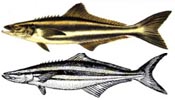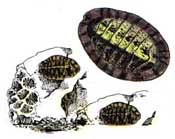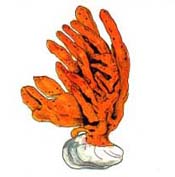 |
Cobia – Rachycentron canadum, Their flat head, protrucing lower jaw, and short isolated dorsal spines distinguish Cobia from other species such as Remoras (or Sharksuckers). They average in length from 4 – 6 ft. and a large Cobia may weight as much as 100 lbs. They live in warm water open seas, although they are sometimes found near shore around barrier islands and coral reefs. They sometimes travel in schools, but mostly are solitary. They can be found in the company of larger fish and sharks looking for food scraps and protection. They also feed on small botom fishes and crustaceans. |
| |
 |
Common Bay Scallop – Aequipecten irradians, Among the dense meadows of sea grass lives the wary scallop; with sapphire blue eye spots, it sees approaching predatory snails or starfish, snaps its valves and leaps away with spasmodic jerks. The young attach to grass blades with thread-like hairs, and grow rapidly in one season. Their life span is about 12 months. |
| |
 |
Common Chiton – Chaetopleura apiculata, A primitive mollusk that is found on shells and rocks grazing on algae. Its shell is actually eight plates encircled by a tough mantle. |
 |
Cowfish – Lactrophrys tricornis, Its scales are fused together to create a protective armor, and the two prominent "horns" over its eyes give it its name. Their small mouth is adapted to eating crustaceans. They are also considered a gourmet's delicacy. |
 |
Devil's Finger Sponge – Axinella polycapella, and other species. Often found uprooted from its rocky bottom and cast up on the shores of Alligator Point in the Florida panhandle. The orange, yellow and red colors give it a striking appearance. Class Demospongiae |
| « Previous | Next » |





